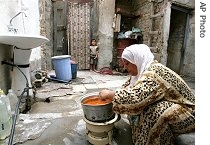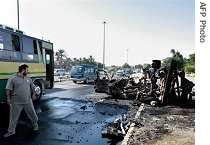2007年VOA标准英语-Baghdad Residents Say Electricity, Water as Imp(在线收听)
Baghdad
26 June 2007
The deployment of 28,000 additional U.S. troops to secure Baghdad is now complete. The troops began arriving in February, and have been focusing their mission on clearing troubled neighborhoods of al-Qaida and illegal militias. From Baghdad, VOA's Margaret Besheer reports on one area where U.S. and Iraqi forces are working to bring security and return basic services to residents.
The streets of Yarmouk are quiet in the searing mid-day heat. This western Baghdad neighborhood is one of the wealthiest in the capital and many of its residents have fled the sectarian killings, kidnappings, and bombings that have been gripping the capital during the past 16 months.
But after four years of war, residents here complain as much about the lack of electricity and water as they do about security.
 |
| An Iraqi woman cooks on a gas stove in the outdoor yard of her house during an electricity power cut, 27 May 2007 |
"One night my son goes from five o'clock in the morning, and he is still in the station at seven [in the] evening and he did not get anything," said Mrs. Samir.
Next door at Abdul Melhem's house, his family is in mourning for his brother who gunmen shot dead two days before. He agrees basic services are in shambles.
As his eyes fill with tears he says, it is one thing to lose services, but to lose people is a different issue. He says no one is safe at home or on the street.
But Iraqi Army Colonel Ali al-Obeidi, whose unit is responsible for security in the area, along with the U.S. Army's 2nd Battalion, 32nd Field Artillery, 1st Infantry Division, says in recent weeks about 100 families have returned to the area, a sign their confidence is rising.
He says the biggest problem security forces in this area faced was from al-Qaida. But in his view, all the al-Qaida members in Yarmouk have been now been apprehended and the area is relatively quiet.
 |
| An Iraqi walks away from the site where a car Bomb and an improvised explosive device exploded simultaneously at Kahtan square in Baghdad's Yarmouk area (Sep 2006) |
Captain Jason Morgan of the 32nd Field Artillery says when his unit arrived four months ago there was one road in Yarmouk where they regularly found dead bodies.
"In past three months, we have had zero body drops on that road," he said. "I would say that is a pretty good metric for success."
Yarmouk's biggest problem appears to be the neighborhoods to the west and north of it, where problems still abound.
On a recent afternoon VOA visited the local police station, which also has responsibility slightly north of Yarmouk. A few hours later, the police captain in charge was killed.
He and other officers responded to a call about two dead bodies on a street in the northern area. When they arrived the booby-trapped bodies exploded and small arms fire rang out. The captain was killed and one of his men was injured.
When VOA visited the same police station about two months ago, the captain's uncle had just been kidnapped and killed.
Yet despite the violence, Yarmouk is safer than most Baghdad neighborhoods for locals and U.S. troops. Since American forces arrived in the area in February, not one U.S. soldier has been killed.